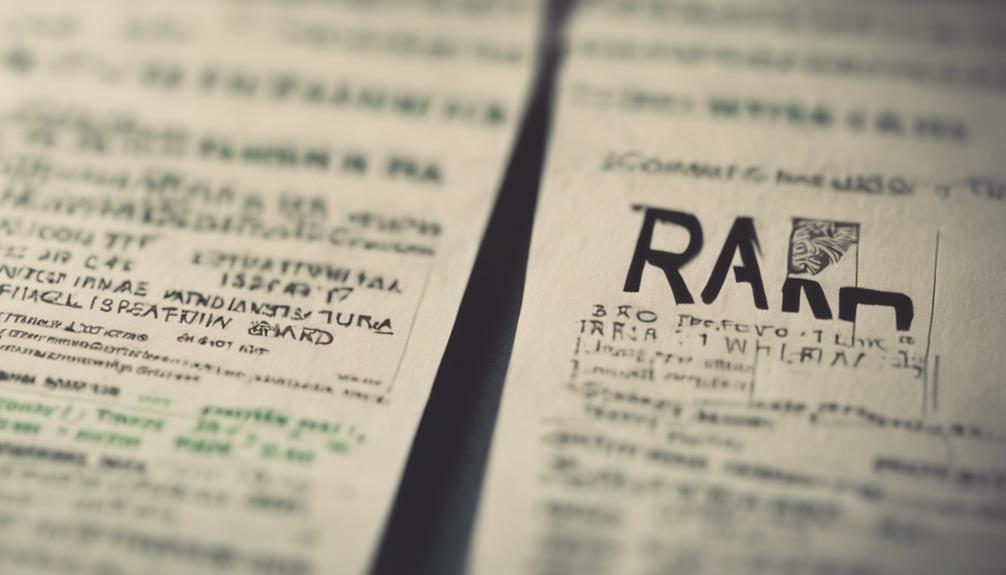To learn more about Roth IRA investing, you can contribute after-tax dollars to a retirement account. You have the option to invest in securities such as stocks, bonds, ETFs, or mutual funds. Experience tax-free growth on your investment gains. Select options based on your risk tolerance and financial goals. By doing so, you are creating a tax-free income source for retirement. With 2024 contribution limits set at $7,000 and income eligibility based on MAGI, you can strategically plan your finances. Tax benefits and withdrawal rules provide flexibility and advantages for retirement planning. For a more in-depth understanding of how Roth IRA investing operates, explore eligibility criteria, contribution limits, and various investment options for your financial future.
Key Takeaways
- Contribute after-tax dollars to a Roth IRA for tax-free growth.
- Invest in securities like stocks, bonds, and mutual funds.
- Choose investments based on risk tolerance and financial goals.
- Enjoy tax-free withdrawals after age 59½.
- Monitor investments regularly for long-term financial growth.
Basics of Roth IRA Investing

When you start Roth IRA investing, you contribute after-tax dollars to a retirement account. Roth IRAs offer a unique advantage as they allow you to invest in various securities such as stocks, bonds, ETFs, and mutual funds.
One of the key benefits of Roth IRA investing is the tax-free growth on your investment gains, which can lead to significant long-term growth potential. Within a Roth IRA, you have the flexibility to choose your investment options based on your risk tolerance and financial goals.
This type of retirement savings account enables you to build a tax-free source of income for your retirement years. By making regular Roth IRA contributions and strategically managing your investments, you can work towards generating tax-free income in the future.
It's essential to understand the mechanics of Roth IRA income and how your contributions and investment choices can impact your financial security during retirement.
Eligibility and Contribution Limits

To contribute to a Roth IRA, you need to meet income eligibility criteria based on your Modified Adjusted Gross Income (MAGI).
The contribution limits for 2024 stand at $7,000, with an extra catch-up allowance for those aged 50 and above.
It's important to understand how your income level affects your eligibility and the maximum amount you can contribute to your Roth IRA.
Eligibility Criteria Overview
Determining your eligibility for a Roth IRA hinges on your Modified Adjusted Gross Income (MAGI), with the IRS setting contribution limits for the upcoming tax years. Income limitations based on MAGI apply, and Roth IRA contributions are not tax-deductible. Maximum contribution amounts decrease at specific income levels for Roth IRAs. Here is a summary of the eligibility criteria for Roth IRAs:
| Eligibility Criteria | Description |
|---|---|
| MAGI | Determines Roth IRA eligibility |
| Contribution Limits | Set by the IRS for each tax year |
| Income Limitations | Based on MAGI for eligibility |
| Tax-Deductible | Roth IRA contributions are not tax-deductible |
| Maximum Contribution | Amounts reduce at specific income levels |
Contribution Limit Details
When contributing to a Roth IRA, keep in mind that your eligibility and the contribution limits are determined by specific income criteria set by the IRS. For the tax year 2024, the maximum contribution limit is $7,000, with an additional catch-up contribution of $1,000 allowed for individuals over 50.
Income limits play a significant role in Roth IRA eligibility, impacting your ability to make contributions. Please be aware that contributions to Roth IRAs are made with after-tax dollars and aren't tax-deductible. The IRS periodically sets Roth IRA contribution limits, which can vary based on income levels.
Understanding these limits and guidelines can help you effectively plan and manage your retirement savings through a Roth IRA.
Income Requirements for Eligibility
Understanding the Modified Adjusted Gross Income (MAGI) is essential for determining your eligibility and contribution limits for Roth IRA investing. The table below outlines how specific income levels affect your eligibility and contribution limits for a Roth IRA:
| Income Level | Eligibility | Contribution Limit |
|---|---|---|
| Below Limit A | Eligible | Full Contribution Allowed |
| Between A and B | Partial Eligibility | Reduced Contribution |
| Above Limit B | Ineligible | No Contribution Allowed |
Investment Options for Roth IRAs

When considering investment options for your Roth IRA, you'll find a diverse range of choices such as stocks, bonds, ETFs, mutual funds, and more.
These options provide you with the opportunity to tailor your portfolio based on your risk tolerance and financial objectives.
Diverse Investment Choices
Consider the diverse investment choices available for Roth IRAs to optimize your portfolio and achieve your long-term financial goals.
1) Stocks: Offer growth potential but with higher volatility.
2) Bonds: Provide stability and income but with lower returns.
3) Real Estate Investment Trusts (REITs): Allow investment in real estate without direct ownership.
4) Roth Self-Directed IRAs: Enable a broader investment selection beyond traditional options.
Diversifying your Roth IRA with mutual funds, ETFs, CDs, and precious metals can help manage risk and enhance potential returns. Remember, the investment mix in your Roth IRA plays a significant role in shaping your retirement savings growth.
Tax Advantages for Investing
To fully leverage the tax advantages of Roth IRA investing, explore the various investment options available, ranging from stocks and bonds to ETFs and mutual funds. Roth IRAs offer the benefit of contributing after-tax dollars, allowing your earnings to grow tax-free.
The flexibility of investment options within Roth IRAs enables you to build a portfolio with diverse investments, potentially maximizing your growth opportunities. Additionally, the tax-free growth and withdrawals make Roth IRAs attractive for long-term investing strategies.
Tax Benefits and Withdrawal Rules

Enjoy tax-free growth on your contributions and earnings with Roth IRA investing. Here are key points to ponder regarding tax benefits and withdrawal rules:
- Tax-Free Withdrawals: Roth IRA withdrawals after age 59½ are tax-free and penalty-free, allowing you to access your funds in retirement without incurring additional taxes.
- After-Tax Contributions: Contributions to a Roth IRA are made with after-tax dollars, offering tax advantages in retirement as you won't be taxed on withdrawals of your original contributions.
- Flexible Withdrawal Rules: Roth IRAs have flexible withdrawal rules, making them advantageous for those who may need to access funds before retirement age without facing penalties on contributions.
- No Required Minimum Distributions (RMDs): Unlike Traditional IRAs, Roth IRAs aren't subject to required minimum distributions (RMDs) during the original account owner's lifetime, providing more control over when you choose to withdraw funds.
Roth IRA Vs. Traditional IRA

As you weigh your options for retirement savings, comparing Roth IRAs to Traditional IRAs can help you make informed decisions about your financial future.
Roth IRAs offer tax-free withdrawals in retirement, while Traditional IRAs provide tax benefits at contribution. Additionally, Roth IRAs have more flexible withdrawal rules compared to Traditional IRAs.
When it comes to wealth transfer, Roth IRAs allow for tax-free transfer to beneficiaries, making them advantageous for legacy planning. On the other hand, Traditional IRAs require mandatory distributions, unlike Roth IRAs, which don't have required minimum distributions.
Moreover, Roth IRAs provide a way to avoid taxes on inherited retirement savings, offering benefits for your beneficiaries. Understanding the differences between Roth IRAs and Traditional IRAs is important for making the right choice based on your financial goals and retirement planning needs.
Steps to Open a Roth IRA

When opening a Roth IRA, start by selecting a reputable broker or financial institution to establish your account. To make sure you meet eligibility criteria, verify your income against the set limits and understand the contribution rules.
Decide on your initial contribution amount, keeping in mind the yearly limits that apply. Once your account is set up, you can select from a variety of investment options such as stocks, bonds, ETFs, and mutual funds to build your portfolio.
It's important to regularly monitor and adjust your investments to align with your financial goals and risk tolerance. By staying informed and making informed decisions, you can make the most of your Roth IRA for long-term financial growth.
Frequently Asked Questions
How Does Roth IRA Invest My Money?
When you invest in a Roth IRA, your money is allocated to various securities like stocks, bonds, mutual funds, ETFs, and CDs. The specific investments you choose are determined by the financial institution where you hold your Roth IRA. This allows your funds to potentially grow tax-free over time, enabling compound growth.
Your investment strategy can be tailored based on your risk tolerance and financial objectives, aiming to create a tax-free income stream for retirement.
How Do You Make Money From a Roth Ira?
To make money from a Roth IRA, you benefit from tax-free growth on your contributions and earnings. Your investments can grow through compound interest, dividends, and capital appreciation.
How Much Will a Roth IRA Grow in 10 Years?
In ten years, your Roth IRA's growth can vary based on contributions, investment choices, and market performance. With an average return of 7-10%, it could potentially double in value. Compounding interest on contributions and earnings can lead to substantial growth.
Diversified portfolios can enhance your contributions considerably over a decade. Tax-free growth can build a substantial retirement savings nest egg.
How Much Will a Roth IRA Earn in 20 Years?
Over 20 years, a Roth IRA can potentially earn considerably due to contributions, investment returns, and compounding.
With an average annual return of 7%, your Roth IRA could almost double in value in two decades.
Consistent contributions and a diversified investment approach are key to boosting earnings.
The power of compound interest over time can substantially grow your Roth IRA by leveraging both contributions and investment gains.
Conclusion
To sum up, Roth IRA investing operates by allowing individuals to save for retirement with tax-free growth potential.
Like a steady ship sailing through unpredictable waters, a Roth IRA offers a stable and secure way to build wealth for the future.
By understanding the basics, eligibility requirements, investment options, and tax benefits, you can make informed decisions to secure your financial future.
Start your journey towards financial security by opening a Roth IRA today.









